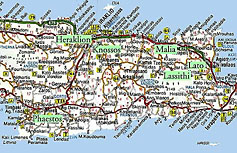
We were up at a reasonable time for a 9:15 taxi to the airport. At breakfast we met MaryAnn and Lanny North, who were also going to Crete. They gave us the name of their hotel in Heraklion, and we arranged to contact them when we got settled. At the airport, the Olympic Airways terminal building was not the same terminal building as the one we arrived at, but is at the other end of the airfield. It gave the impression of being rather run down, which we were later to find to be characteristic of Olympic Airways. (Our Lonely Planet guide listed Olympic Airways as one of the ten bad things about Greece!). Getting onto the plane from the transporter bus was a bit chaotic, and the seats were so cramped that when the man in front of me put his seat back, my kneecap was very painfully squashed by the metal seat frame, and there was nowhere I could put my leg to escape. The flight to Heraklion was on time, and we had a fine view of the island of Milos, so not everything about it was bad.
 |
| East Central Crete: Click for a larger map that will open in a new window you can keep open. |
Heraklion airport is entered by way of a wide flight of marble steps and a marble lobby. Marble seems to be about the cheapest building material all over Greece! When we had gathered our luggage, we looked for the travel agent who was supposed to meet us and take us the the hotel, but there was nobody, and the traveller's aid could not help, since we didn't know the local agency name. So we took a taxi, thinking our hotel was in Heraklion. But it wasn't. "L. Herssonissou" turned out to be the name of a town, not of a street in Heraklion, and it was 30 km away to the east, which was a bit of a shock, since we had thought of walking over to the bus terminal to go to Knossos. The taxi cost 6000 drachma, which he claimed to be the listed price to Herssonissou, and we got a receipt, which was later refunded by the travel agency that should have met us. They said the listed price was 5000 drachma, but since we had a receipt, they gave us the full 6000.
What happened that we were not met? Olympic Airways, that's what. They had
informed the travel agency that the plane was going to be three hours late,
which apparently is normal for them, so the agent had planned to arrive then.
We found this out when we arrived at the hotel and asked the desk to phone the
agency that had booked the rooms. The agency couldn't understand how we were
already at the hotel when Olympic Airways had told them we would still be in
Athens. A very pleasant young lady with the name of Silvana came by later and
refunded our taxi fare, and discussed with us what we might do while on Crete,
and assured us that there would be no mix-up on our ferry trip to Santorini
three days later. (There wasn't, but on arrival
in Santorini we found that Olympic Airways had screwed us up again--but
that's a story for later).
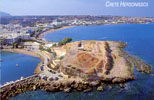 |
 |
 |
| A postcard of Hersonissos. The harbour is at the near left. Our hotel was out of the picture left by about 500 m. | Flowers on the harbour wall. These strange fleshy-leaved flowers opened when it was light, but closed in the rain. They grow wild all over. | The seafront of Hersonissos from the harbour. The Silva Maris hotel is near the left end of the scene. |
Hersonissou has many spellings (even in Greek) It can start with a "Ch-" or a simple "H-" and it can end "-sson", "-ssos" or "-ssou", making six English spellings, and I seem to remember it as sometimes having a double "n" in the middle, as well. The town is very touristy, consisting mostly of a main street a block or so back from the sea, lined with car rental agencies, jewellery shops, restaurants, hotels, postcard stands and other places thought to interest tourists. In spite of that, it is not unattractive, though I can imagine it might be pretty crowded in the high season.
The Hotel Silva Maris in Hersonissou is a very Hollywood kind of place, but quite pleasant in spite of that. It consists of several one- or two-storied buildings casually scattered around two large swimming pools. Our room was on the ground floor with a small patio facing the sea across a pedestrian road. It gave an impression of intimacy although the hotel has some 400 (I think) rooms. A public Web-access computer was in the lobby, usually occupied, though I managed to get on it a couple of times to send and receive e-mail. As the buildings were scattered around the swimming pools, so were the sunbathers, most of whom were on the wrong side of middle age, though a few were distinctly photogenic (and knew it).
We bought some local wine and drank it on our patio after walking along the coast and around the harbour. At the harbour there are some excavated ruins of an early Christian basilica (which you can see in the middle of the postcard picture), but it doesn't seem to be a serious archeological site. Some mosaic floor is visible, and some walls, but mostly it seems to be just a pretty spot for people to come and watch the blue sea.
We took a local bus to Heraklion. We were told that the bus came every half hour, but they were not sure at what time past the hour, so we waited at the bus stop just down the street from the hotel. After a while another couple joined us, but when a bus came going the other way, they crossed the street and got on it, so we wondered whether perhaps the bus made a loop and we should have got on that one. But eventually our bus came, after we had been waiting 40 minutes. It was quite funny. There was a ticket taker who sat beside the driver when he wasn't collecting from the people who got on at the last stop. Halfway to Heraklion, he got off and got on another bus that was following close behind, and a little later he got back on our bus.
The trip took nearly an hour, but it was interesting to go through all the little villages, especially as the church services were getting our, and many of the people were carrying what were probably palm fronds, it being Palm Sunday. The road at some points went by some good sea-cliff scenery, but for the most part it was a rural road of unremarkable quality, neither good nor bad.
At the Heraklion bus terminal, which was very close to the harbour, we changed to the Knossos bus. That was packed tight, with standing room only, even though we were before the real tourist season and the buses ran every 15 minutes. It had been a German bus, as all the signs inside it to inform the passengers were in German.
When we went from the bus to the ticket sales booth, we passed a big black limousine with a Chinese flag, and a waiting chauffeur. After we got our tickets, we went to the site entrance to hand them in, and there we had a major surprise. As we were about to go in, who should come out but Zhang Zemin, the President of China! I was within about 6 feet of him. As he walked past us, he was chatting with another man, there were three or four security people and a few TV people, but there was no attempt to keep us away from him, or to clear the area. I cannot imagine the President of the USA or any other world power visiting such a site with so little security and so much self-assurance!
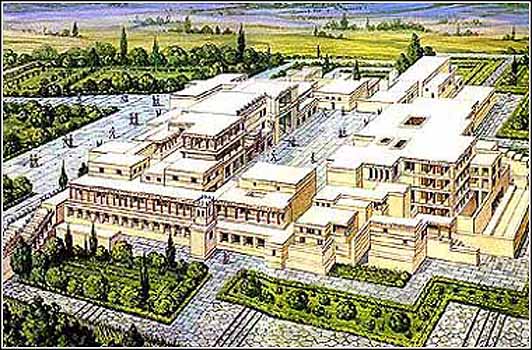 .
There are several Web sites with pictures and descriptions of Knossos and its
history. This one is where
the picture at left comes from, and here
is another example. And here
is a site with a visual tour of the Palace. The sketch at left of how the palace
may have looked in its heyday is from the first of these sites. All the links
in this paragraph open in a new window.
.
There are several Web sites with pictures and descriptions of Knossos and its
history. This one is where
the picture at left comes from, and here
is another example. And here
is a site with a visual tour of the Palace. The sketch at left of how the palace
may have looked in its heyday is from the first of these sites. All the links
in this paragraph open in a new window.
 |
Knossos was the main Minoan palace. Its heyday was in the two centuries or so ending in 1650BC (according to paleoseismic data--the date used to be thought to be 1450 BC). It was probably the Labyrinth of the Minotaur of Greek legend. It must indeed have been quite difficult to find one's way around in, as it is quite enormous in extent, and it has lots of corridors at right angles, and several floors connected by many stairways. Frescos that were found (only replicas are now at the site) show that the roof was surrounded by formalized, abstract, bull-heads, one of which was on display. It is about 1 m tall. Surprisingly, much of the building technique looked almost identical to the present day methods of building Greek houses, that we had seen all over the countryside on our bus tour last week.
 |
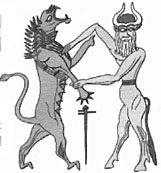 |
| Part of a Sumerian seal from about 2000 BC. Rohl ,1998 inteprets the bull-man as Gilgamesh. (Rohl,p170) |
If Knossos was the Labyrinth of the Minotaur, the legend may have come about not from any sinister plot on the part of the Minoans to take Athenian boys and girls as tribute, but because of the bull-leaping games. Bull leaping was clearly dangerous.The leaper would try to dive over the horns of the charging bull to a handstand on its back, and off again onto his or her feet. Boys and girls both participated, and it is not unreasonable to suppose that some were killed.
One can easily imagine that there might have been an annual festival at which
youths would come from all around to participate, as at the Olympic Games 1000
years later (and now). Some of those who came would probably have been killed,
and others may have chosen not to return from the glamorous Minoan civilization
to the relatively primitive Greece that they might have left. It is not unreasonable
to suppose that in Greece an aura of dread might have surrounded the departure
of the youths for the festival from which some would never return, and for that
half-remembered dread, a thousand years later in Classical Athens, to have turned
the festival that centred around humans and bulls in a dangerous game into a
devouring monster, half bull, half human, especially since the half-man half-bull
image had been part of the iconography of the Mesopotamian cultures and probably
also of Crete since at least 2000BC. ( Further
discussion of the legend is here. And further discussion of the possible
relations between Sumerian and Minoan
culture is here)
Here are some pictures of Knossos (and a few more are on this page). The ones on this page were provided by Lanny and MaryAnn North. We encountered them unexpectedly in Knossos, having missed them at their hotel, and we arranged to meet them the next day with a car, so that we could all visit Phaestos.
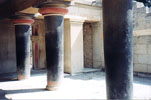 |
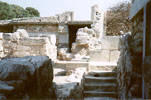 |
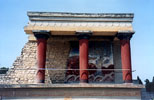 |
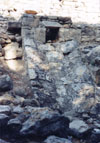 |
| Some pictures of the Knossos Palace provided by the Norths. From left to right: (1) A room showing both the inverted (Minoan) taper of the columns and the modern-looking pillar and beam construction; (2) a less reconstructed area; (3) a portico with a magnificent fresco in bas-relief featuring a bull; and (4) one of the many drains that kept the palace sanitary. | |||
After leaving Knossos and taking the bus back to Heraklion, we wandered through the town a little. The Archeological Museum was closed, but we saw enough of the town to understand it and find our way around when we returned a couple of days later. As we discovered, Heraklion and Crete had been a Venetian colony, but the Turks attacked it in the 17th century. They captured Heraklion only after a siege of many years, when the rest of Crete had been taken and the Venetians decided it was no longer worth hanging on to Heraklion.
 |
 |
| Heraklion, the inner harbour. (Left) The Venetian Fort. (Right) The city. At the left along the waterfront, Venetian warehouses. | |
The bus back to Hersonissos was as odd as the one in the morning. Again there were two buses, but this time it was some of the passengers (including us), as well as the conductor, who had to change buses at a roadside junction, as the bus we were on decided to bypass Hersonnisos, leaving the one behind to go into the town..